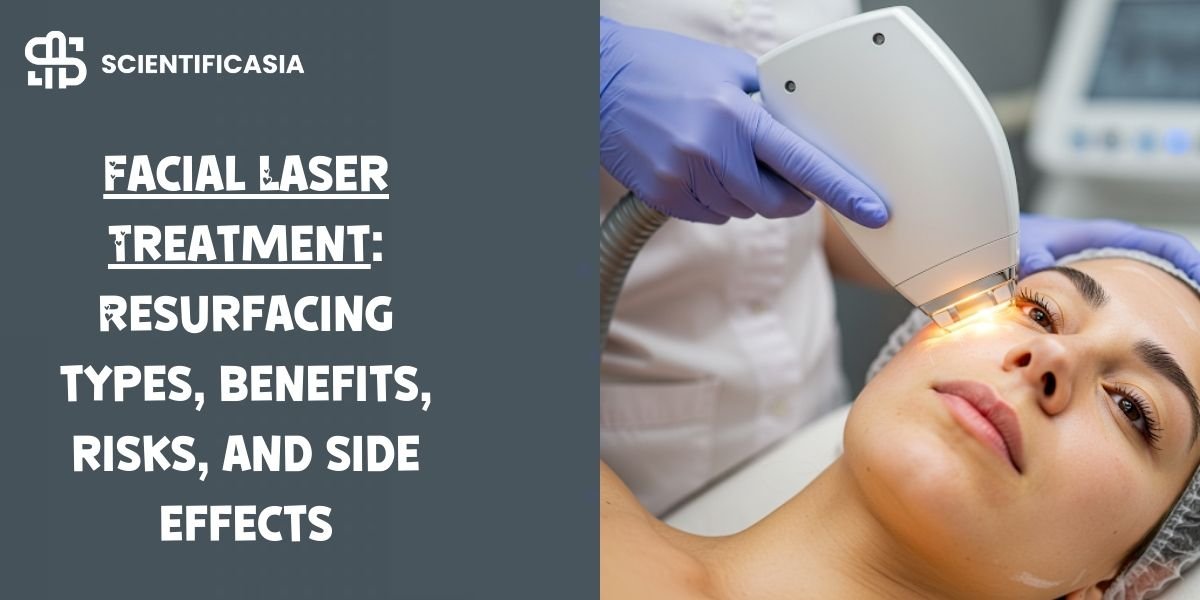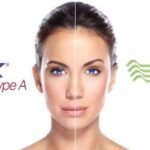Introduction:
Facial laser treatments are a popular method for improving skin health and appearance. From decreasing wrinkles to eliminating acne scars, laser resurfacing offers a versatile therapy for various skin conditions. This article will go into excellent length on the many types of face laser resurfacing, as well as its benefits, drawbacks, and potential adverse effects. Its wide and growing range of uses highlights questions about the performance, reliability, and suitability of laser and IPL treatment. Here, we look at these and other major problems with the use of those methods to treat patients with skin problems.
What is Facial Laser Treatment?
Facial laser treatment treats a variety of skin disorders with a focused light beam. This helps to eliminate damaged skin and promotes the formation of new, healthy skin. Depending on the treatment, laser resurfacing can help with wrinkles, acne scars, discoloration, and skin color differences.
There are several varieties of lasers that are utilized for various issues, and their intensity ranges from mild therapies to more severe ones that can require a longer period of healing.
Types Of Facial Laser Resurfacing:
There are different types of facial laser resurfacing available, each one formulated to treat a unique skin problem. To pick the right treatment for you, it’s important to know what sets each of them apart.
- Ablative lasers:
- Nonablative lasers:
- Fractional lasers:
Ablative Laser:
These more powerful lasers remove the upper layers of skin. These lasers are particularly effective in treating severe sun damage, scars, and deep wrinkles. Furthermore, there are two of the most common types of ablative lasers.
- Erbium laser
- CO₂ laser
Non-ablative Laser:
Non-ablative lasers, which remove the top layer of skin, are far milder and leave the skin intact. To encourage collagen formation without harming the surface, they instead focus on the deeper layers of the skin. Common uses for these lasers include smoothing out skin texture, lowering pigmentation, and treating moderate to severe wrinkles. This laser also has two types:
- Er. YAG laser
- IPL
Fractional Laser:
You can get fractional lasers that are ablative or non-ablative, but they only fix a small area of skin at a time. This means they make small, controlled cuts in the skin while keeping the tissue around the wound whole. This method helps people heal faster and cuts down on recovery time while still getting good results.
- Fractional CO₂ Laser
- Fraxel Laser
Benefits of Facial Laser Resurfacing:
A facial laser treatment can help you achieve smooth, glowing skin. There are many different types of facial resurfacing benefits. Some of them are the following:
Reduce fine lines and wrinkles:
Wrinkles can be reduced with laser treatments because they promote collagen development. As we become older, our bodies produce less collagen, a protein that helps keep our skin in place. Laser treatments can help diminish wrinkles by increasing collagen production.
Minimize the large-sized pores:
Factors like heredity and the natural aging process can contribute to the development of large pores. Large pores can have their size reduced using laser treatments by heating the surrounding tissue. This aids in skin tightening and diminishes the look of pores.
Improve the skin tone and texture:
Loss of skin suppleness is a natural part of getting older. As a result, the skin may droop and look slack. By increasing collagen production, laser treatments can tighten the skin. As we become older, our bodies produce less collagen, a protein that helps keep our skin in place. Laser treatments can tighten skin by increasing collagen production.
Improve the appearance of pigmentation:
A variety of factors, including sun exposure, aging, and heredity, can contribute to pigmentation, a prevalent skin disorder. By destroying the pigment-laden skin cells, laser treatments lighten pigmentation by facilitating their absorption by the body. This improves both the skin’s tone and complexion.
Reduce the acne scars:
Facial laser treatment is highly effective for smoothing out the texture of acne scars and making them less noticeable. Acne, surgery, and injuries are just a few of the many potential causes of scars. By burning the scar tissue, laser treatments can reduce their visibility. The skin’s texture is enhanced as a result. Laser treatments can induce collagen, which can fill up scars.
Age spots and sun damage:
Laser resurfacing helps fade age spots, sun damage spots, and other types of sun damage, leading to a more even skin tone.
Tighten the skin:
This product addresses both skin laxity and sagging by tightening and firming the skin overall. By laser resurfacing treatment, skin looks young.
Risks and Side Effects of Laser Treatment:
Common side effects:
Peeling and dryness:
After facial laser treatment, it is common to peel out the skin and dryness. After 4 to 6 weeks, the peeling and dryness typically subside on their own. Peeling and dryness of the skin is just a part of healing skin after the procedure. Do not scratch or irritate the area while it heals.
Redness and itching:
In most circumstances, laser treatments are associated with a mild side effect known as minor redness. This side effect may disappear rapidly or, in more severe cases, may last for many months.
Swelling and discomfort:
Following treatment, your skin may experience swelling and discomfort. After receiving ablative laser treatment, your skin may continue to seem irritated for a period of many months.
Changing in skin color:
Laser resurfacing can darken or lighten skin. Post-inflammatory hyperpigmentation darkens the skin, and hypopigmentation occurs when it loses color. Brown or Black skin is more likely to change color over time. If this is a problem, see a laser professional who has selected settings for different skin hues.
Tiny White bumps:
Milia are microscopic white bumps that form after surgery. Dead skin cells trapped in microscopic pockets under the skin form milia. Facial milia are usually near the eyes or cheeks. Though harmless, they can be annoying and typically go away. Milia can last weeks but can be discussed with reduced exfoliation or dermatological treatment.
Serious side effects:
Burns:
Incorrectly performed laser hair removal or treatments might cause burns and blisters. Depending on your skin type and other underlying disorders, they may rarely develop under treatment by a licensed practitioner, although this is quite unusual. To avoid burns and the side effects of the skin’s natural cooling mechanism, practitioners may utilize a cooling device before applying high-heat laser therapy to dissolve pigment or hair follicles.
Scaring:
Scarring is a very unusual harmful effect of laser treatment; however, scarring can occur as a result of human mistake or improper laser device use. Ensure you strictly adhere to all your practitioner’s aftercare instructions to prevent scarring, as improper aftercare can also lead to scarring.
Infection:
Laser resurfacing has the potential to cause an infection caused by bacteria, viruses, or fungi. An outbreak of the herpes virus, which is the virus that is responsible for cold sores, is the most prevalent type of infection.
Pigmentation changes:
You may sometimes see changes in the color of the treated area, such as it getting darker or lighter. People with darker skin are more likely to have this happen to them. This side effect could last a long time or only last a short time, depending on the type of laser used.
Before Care of Laser Resurfacing Treatment:
Tell about your medical history:
We will inquire about your current and past medical conditions, along with any medications you are currently taking or have taken in the past. You might also face questions about recent cosmetic treatments you’ve received and your response to sun exposure.
Physical exam:
A member of the care team inspects both your skin and the area undergoing treatment. As a consequence, the inspection serves to demonstrate what kinds of changes are possible and how the characteristics of your skin could influence the outcomes of therapy. In addition, the examination assists in determining the chances of having problems.
Take medicine to prevent side effects:
In order to prevent you from becoming infected with a virus, you could be given a prescription for an antiviral medication both before and after treatment.
Stop smoking:
Throw away the cigarette. An alternative is to abstain from smoking for the two weeks preceding and following your therapy. As a result, your body has a better chance of recovering quickly and experiencing fewer adverse effects.
During the Procedure of Facial Laser Treatment:
Most of the time, laser resurfacing is done in a clinic. Because it’s not performed in a hospital, this is sometimes called an outpatient treatment. Your care team puts medicine on the skin to numb it. To treat your whole face, your care team may give you a drug that makes you feel calmer or less stressed. The word for this is relaxation. During ablative laser treatment, your skin receives a strong stream of light energy. The epidermis, which is the top layer of skin, is burned off by this laser beam. At the same time, the laser burns the dermis, which is the skin below the surface. Over time, this makes your body make more collagen, which makes your face smoother.
Depending on the method employed and the amount of the treated region, relative laser resurfacing usually takes 30 minutes to 2 hours. In the absence of a fractional laser, this method typically requires a single session. To get the desired outcomes from nonablative laser therapy or fractional Er:YAG laser resurfacing, you will probably require two to four sessions spaced out over weeks or months.
After the procedure for facial laser resurfacing:
After ablative laser resurfacing, swelling and itching are likely to occur on the afflicted skin. The pigmentation of the skin may change. After applying a viscous ointment to the afflicted area, your medical team may cover it with an occlusive, impermeable dressing. One could use cooling packs and an analgesic. It usually takes 7 to 10 days for new skin to emerge. At least one month is needed for full recovery. Avoid using cosmetics or other items that might irritate your face during this period. Additionally, stay away from places like public whirlpools that raise your risk of infection. After laser resurfacing, always use sunscreen.
Results and maintenance of facial laser resurfacing:
The healing process following laser resurfacing is quick. Your skin may get larger or change color for a few hours. Use ice packs when necessary. In most cases, you may immediately resume your regular skincare routine and activities. As the treated area begins to heal, your skin will feel and look better than it did before the procedure. They could persist for a while. Over time, laser resurfacing typically results in gradual but discernible changes. You could see an improvement in the texture and tone of your skin instead of a decrease in wrinkles. You will require two to four treatments to witness the outcomes of fractional ablative and fractional non-ablative procedures. These kinds of sessions are frequently scheduled across several weeks or months.
To maintain your skin’s youthful appearance, you may need maintenance treatments. If more appointments are necessary, your dermatologist can advise you on when to arrange them.
Conclusion:
Facial laser resurfacing is a complete and modern way to make your skin look younger. It can treat a wide range of skin problems with custom treatments. Ablative lasers, such as CO2 and Er: YAG, can help with deeper skin problems, but they come with more risks and take longer to heal. Non-ablative technologies help the skin make more collagen and smooth it while causing little to no damage to the surface. These are excellent for lesser problems and require little recovery time.
Fractional lasers offer a combination of speedy recovery and reduced complications. Carefully choosing patients based on their skin type and goals makes sure that the process goes smoothly and safely. As non-ablative laser technology improves in the future, it should become easier to aim and go deeper into tissue. Researchers are looking into how to use different methods together to get better results and treat more skin problems. Facial laser treatment is becoming more popular because new technologies and research are expected to make therapies more successful, give people more choices, and make them safer, especially for people with darker skin.










